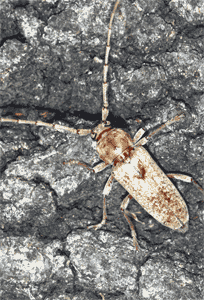One of the nice things about being an Extension entomologist is that I get to hear what's going on out there in your lives without all the hard work of following you around. Specifically, I get to hear stories about you from your customers. This week's story has to do with a not-too-common insect that puzzled several of you recently, and one that had me donning my Sherlock Holmes' cap.
The new homeowners were experiencing an invasion of little larvae in their living room, near a fireplace...no food or obvious source of the critters nearby. I had about a dozen specimens in hand, and the homeowner reported seeing that many every day for at least the past two weeks. At least three PMPs examined the insects; one determined that they were "maggots", another suggested old house borers (the people were finding a dozen or so each day on their hardwood floors), another hadn't a clue.

Since this wasn't a no-brainer for me either, bear with me as I share my thought process used to determine the identity of these insects (see picture). As you read, see if you can guess the final diagnosis.
Like a garage mechanic trying to diagnose an old car, entomologists commonly use the process of elimination and deductive reasoning to explain strange insect problems--of which this industry sees of lot. My sample was certainly an insect, because it had six-legs, but fly maggots (say from a carcass) were out of the question because fly larvae are legless. At first glance at these little guys reminded me of Indian meal moth, the most common, similar sized larva found in similar situations in homes. But my insects did not have prolegs (the fleshy claspers found on the abdomenal segments of moth and butterfly caterpillars. Because of their prominent legs, caterpillar-like shape, and lack of prolegs I knew they were some type of beetle.
I immediately knew they could not be old house borer or any kind of wood-boring beetles because insects that live in wood are usually white and their legs tend to be microscopic--very small, if present at all (legs aren't very useful for inching through dark, narrow galleries in the wood). Also, wood borers never leave their safe galleries during the larval life stage.
Insects emerging from stored products are always a prime suspect in cases like this. Although they slightly resembled hide beetles, they lacked the hairy bodies associated with dermestid larvae. I knew from experience that they did not look like the larva of any other
common stored product pests.
So Watson, where does that leave us? Could it be a beetle that sneaked its way indoors around a crack in a window frame, or under a door? Probably not, because there were too many of them to be coincidence, and this is not common behavior for outdoor, plant feeding or carnivorous beetles. If they in fact originated in the house, that left me with two likely remaining sources. They could be some kind of decomposer insect that feeds on dead animals or decaying plant materials. Or they could be an insect that lives in the nests of other animals. With a fireplace nearby either choice seemed likely.
Any guesses? The only obvious, distinctive physical characteristic on these relatively plain beetle were two sets of hooked, horn-like structures on the last segment of the abdomen. At this point a little entomology experience saved a bunch of research time--that, and a quick call to the Texas A&M University entomology museum assistant curator, Ed Riley. Ed and I both had a suspicion, but needed a picture to confirm it. We Googled "hive beetle" and sure enough, at a University-based website (my first choice when faced with hundreds of hits from Google) we saw our culprit.
The small hive beetle,
Aethina tumida, is a relatively new structural pest in this country. It's really not considered a structural pest, but a pest of bee hives where it feeds on bee larvae in their waxen nurseries. I have encountered the adult form of this beetle from samples taken in homes before, but never the larva. I suspect that our industry will see more and more of them as time goes on.
My conclusion? The new homeowners had not yet discovered that along with their new home they had also purchased a bee hive, hidden perhaps in a wall or ceiling area. The hive beetles were the only evidence they had seen of this hive, but as Sherlock Holmes could tell you, the evidence never lies.
These kind of challenges keep our profession interesting and even fun. Perhaps it's no coincidence that
when Sherlock finally retired, he took up beekeeping as his choice of amusement.
For more information about hive beetles, along with images, check out
http://www.bugwood.org/factsheets/small_hive_beetle.html and
http://entomology.ifas.ufl.edu/creatures/misc/bees/small_hive_beetle.htm




